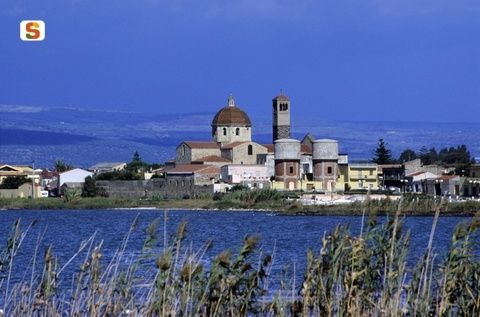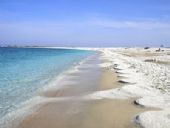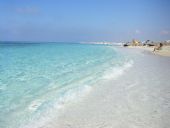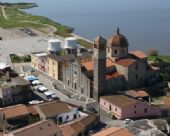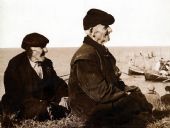
Cabras
a few km. from Oristano
A few km. from Oristano, Cabras is a big country which lies on the eastern shore of the famous lake, the largest in the province.
With an area of ??2,200 acres, it offers visitors a spectacle of extraordinary natural interest, representing the habitat for numerous birds and a rich fish fauna.
Fishermen move lake cones characteristic fassonis, the ancient craft built with reeds lake similar to those of the ancient Egyptians.
In the middle of the pond it stands the islet of Cùccuru is Arrius which were also found in some tombs, the oldest of Sardinia.
A sandy strip separating the Cabras from that of Mistras, which connects to the sea.
Another pond is to Sale Porcus, the largest of a series of lakes that are open to the north west of the Sinai Peninsula; with a minimum depth, it contains a rich colony of flamingos and other species of waterfowl.
Almost at the foot of the promontory of Capo San Marco, it is the church of S. Giovanni di Sinis and the ancient Nuraghe Angius Corruda. North of S. Giovanni di Sinis is the coastline of the promontory and Abbarossa Turr'e Seu, former WWF.
The center offers several points of interest, including the Municipal Museum, located in the suburbs, which displays artifacts found in the necropolis of nuragica Cùccuru is Arrius and Tharros, and the parish church of Santa Maria was built in the sixteenth century. with materials from the castle of which the remains are still visible behind the church.
Along the road to Tharros, meets the underground sanctuary of San Salvatore, built in the Roman period (fourth century AD.)
About ten km. Cabras, in the middle of a village of cumbessias, the typical houses of novenari.
Later used as a Christian church, it contains a sacred well and the remains of valuable paintings related to the rites of salvation taking place on the site.
At the end of the Sinai Peninsula, the Cape San Marco, not far from the town of St. John, is the ancient Phoenician city of Tharros, built as early as the eighth century. B.C. on a pre-existing settlement nuragic become thriving port under the rule of the Carthaginians and Romans.
It constitutes one of the most important archaeological sites in the Mediterranean, where you can admire the remains of an aqueduct, two spa buildings, a Punic temple, a Tophet (sacrificial altar of the Carthaginians) and an early Christian baptistery.
With an area of ??2,200 acres, it offers visitors a spectacle of extraordinary natural interest, representing the habitat for numerous birds and a rich fish fauna.
Fishermen move lake cones characteristic fassonis, the ancient craft built with reeds lake similar to those of the ancient Egyptians.
In the middle of the pond it stands the islet of Cùccuru is Arrius which were also found in some tombs, the oldest of Sardinia.
A sandy strip separating the Cabras from that of Mistras, which connects to the sea.
Another pond is to Sale Porcus, the largest of a series of lakes that are open to the north west of the Sinai Peninsula; with a minimum depth, it contains a rich colony of flamingos and other species of waterfowl.
Almost at the foot of the promontory of Capo San Marco, it is the church of S. Giovanni di Sinis and the ancient Nuraghe Angius Corruda. North of S. Giovanni di Sinis is the coastline of the promontory and Abbarossa Turr'e Seu, former WWF.
The center offers several points of interest, including the Municipal Museum, located in the suburbs, which displays artifacts found in the necropolis of nuragica Cùccuru is Arrius and Tharros, and the parish church of Santa Maria was built in the sixteenth century. with materials from the castle of which the remains are still visible behind the church.
Along the road to Tharros, meets the underground sanctuary of San Salvatore, built in the Roman period (fourth century AD.)
About ten km. Cabras, in the middle of a village of cumbessias, the typical houses of novenari.
Later used as a Christian church, it contains a sacred well and the remains of valuable paintings related to the rites of salvation taking place on the site.
At the end of the Sinai Peninsula, the Cape San Marco, not far from the town of St. John, is the ancient Phoenician city of Tharros, built as early as the eighth century. B.C. on a pre-existing settlement nuragic become thriving port under the rule of the Carthaginians and Romans.
It constitutes one of the most important archaeological sites in the Mediterranean, where you can admire the remains of an aqueduct, two spa buildings, a Punic temple, a Tophet (sacrificial altar of the Carthaginians) and an early Christian baptistery.
- Related products
- Giants Mont'e Prama
- Municipal Museum of Cabras
-
Search
-
Categories
- APP FAITA Sardegna
- HOLIDAY PACKAGES
- CAMPING VILLAGE Sardinia
- Where to eat
- TRANSPORT Sardinia
- BEACHES in Sardinia
- Tours in Sardinia
- KITCHEN traditional Sardinian
- WINES Sardinia
- SPIRITS of Sardinia
- EVENTS in Sardinia
- CORTES Apertas in Sardinia
- SPORT in Sardinia
- MAP Sardinia
- PHOTOS Sardinia
- VIDEO Sardinia
- Useful Numbers Sardinia
- DOGGIE BEACH in Sardinia
- Contact information
- archivio
-
Topics
- Camping e Village Sardinia
- Tourism in Sardinia
- resorts in Sardinia
- Sardinian beaches routes
- Specialties at the table
- South Coast Cagliari
- Costa Rei itinerari
- Ogliastra itinerari
- Nuoro e provincia itinerari
- Gallura itinerari
- Sassari e provincia itinerari
- Oristano e provincia itinerari
- Autunno in Barbagia 2013
- Aerei per la Sardegna
- Traghetti per la Sardegna
- Storia di Sardegna
- Feste e sagre della Sardegna
- Camping Village e Spiagge dog friendly
- Spiagge accessibili con l'amico cane






